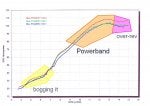I was getting on my bike pretty hard today and got to about 9.5 maybe 10k on the tach when i just JUMPED into the redline passed 11k, it happened in 4th gear, i immediately shifted and then it happened again in 5th. I've had my bike that high in rpms in the past, but i dont think that has ever happened. Just wondered what your thoughts were.

does the ex500 have a "powerband" ??
21 - 40 of 40 Posts
the reason to rev any engine over the red line is to get you closer to the power band after you shift.
if you know that shifting into 5th will put your rpms below the power band with normal shifting, you might want to red line 4th gear so you will be shifting into the power band instead of just under it.
not sure if im explaining this correctly
if you know that shifting into 5th will put your rpms below the power band with normal shifting, you might want to red line 4th gear so you will be shifting into the power band instead of just under it.
not sure if im explaining this correctly
I find it depends entirely on the gear you are in. 1st will pull at any RPM above idle. 2nd is ok down to 2.5K. 3rd prefers at least 3,000. 4th and 5th are unhappy when less than 3,500. 6th needs 4K or more.MrB1obby said:I don't understand, everyone says it runs like a bag of nails under 4000rpm. Mine runs fine until you go below 3000rpm. It has smooth torque from about 3000rpm onwards, good midrange 4500-7000rpm (after the FOGmod) and then goes like the dogs bollocks at 7000rpm until 9500rpm when I change gear.
Lower gear == more torque == less RPM required.
If you don't already know this, a powerband is not an actual object.
It refers to the rpm range where an engine makes it's most power. This may or may not be a "useable" range, like in the case of the R6 (dyno below), unfortunately the US is a numbers game so peak horsepower is marketed more than anything else.
If you are riding an R6 at 3,000 rpms, you will be bogging it.
You then go Wide open throttle (WOT) the revs will climb slowly until you reach 5-6,000 and the bike will start to pull harder. as the revs climb, approaching the powerband the bike will continue to accelerate harder and harder and when you reach the very high RPMs it will pull very quickly into the over-rev range. It is still making a lot of horsepower, but at this point (15,500 rpms) the bike definitely stopped accelerating as hard and it's time to change gears.
If then engine is spinning between 10-14k it is going to be very responsive, have the most overall horsepower and accelerate the hardest.
Hopefully this clears things up a little bit
![Image]()
It refers to the rpm range where an engine makes it's most power. This may or may not be a "useable" range, like in the case of the R6 (dyno below), unfortunately the US is a numbers game so peak horsepower is marketed more than anything else.
If you are riding an R6 at 3,000 rpms, you will be bogging it.
You then go Wide open throttle (WOT) the revs will climb slowly until you reach 5-6,000 and the bike will start to pull harder. as the revs climb, approaching the powerband the bike will continue to accelerate harder and harder and when you reach the very high RPMs it will pull very quickly into the over-rev range. It is still making a lot of horsepower, but at this point (15,500 rpms) the bike definitely stopped accelerating as hard and it's time to change gears.
If then engine is spinning between 10-14k it is going to be very responsive, have the most overall horsepower and accelerate the hardest.
Hopefully this clears things up a little bit
Attachments
-
64.1 KB Views: 327
Joined
·
378 Posts
just so everyone knows I'm aware that there is not a physical object called a powerband...and I never implied that I thought so. I know what the powerband is, i never asked what it is, I was just asking to see if anyone else had experienced similar effects in your ex500.
Joined
·
934 Posts
That's pretty helpful info right there...you don't happen to have a graph for the ex500 do you?Tulok said:If you don't already know this, a powerband is not an actual object.
It refers to the rpm range where an engine makes it's most power. This may or may not be a "useable" range, like in the case of the R6 (dyno below), unfortunately the US is a numbers game so peak horsepower is marketed more than anything else.
If you are riding an R6 at 3,000 rpms, you will be bogging it.
You then go Wide open throttle (WOT) the revs will climb slowly until you reach 5-6,000 and the bike will start to pull harder. as the revs climb, approaching the powerband the bike will continue to accelerate harder and harder and when you reach the very high RPMs it will pull very quickly into the over-rev range. It is still making a lot of horsepower, but at this point (15,500 rpms) the bike definitely stopped accelerating as hard and it's time to change gears.
If then engine is spinning between 10-14k it is going to be very responsive, have the most overall horsepower and accelerate the hardest.
Hopefully this clears things up a little bit
![Image]()
+1boomerro said:your clutch is slipping, adjust it. or remove and inspect the clutch plates and springs.
Joined
·
12,299 Posts
get your adjustable powerbands here
http://kalecoauto.com/index.php?main_page=product_info&cPath=1&products_id=30
they also carry O pipes and blinker fluid.
http://kalecoauto.com/index.php?main_page=product_info&cPath=1&products_id=30
they also carry O pipes and blinker fluid.
Joined
·
378 Posts
I'm not familiar with clutches slipping, what exactly is happening what the clutch "slips"?boomerro said:your clutch is slipping, adjust it. or remove and inspect the clutch plates and springs.
Another note, could it be from changing my oil? I just changed it a couple weeks ago with some Rotella T Synthetic 5w-40.
Engine spins faster than the transmission.jopeters said:I'm not familiar with clutches slipping, what exactly is happening what the clutch "slips"?
Yes, using car oil that is not JASO-MA rated for wet clutches in general, and "energy conserving" oil in particular, can cause clutch slippage.Another note, could it be from changing my oil? I just changed it a couple weeks ago with some Rotella T Synthetic 5w-40.
Joined
·
378 Posts
I know the oil is not energy conserving, and I heard a lot of people using that oil so i figured it would be fine...who knows.tylernt said:Engine spins faster than the transmission.jopeters said:I'm not familiar with clutches slipping, what exactly is happening what the clutch "slips"?
Yes, using car oil that is not JASO-MA rated for wet clutches in general, and "energy conserving" oil in particular, can cause clutch slippage.Another note, could it be from changing my oil? I just changed it a couple weeks ago with some Rotella T Synthetic 5w-40.
Is this Rotella diesel oil? I have heard of a lot of people using diesel oil, so maybe your oil is not the issue here after all. Maybe your clutch just needs adjustment and the oil change made it need that adjustment that much more. There should be a tiny bit of slop (cable slack) in the clutch lever when it's all the way out.jopeters said:I know the oil is not energy conserving, and I heard a lot of people using that oil so i figured it would be fine...who knows.
Joined
·
378 Posts
I'm pretty sure there is some slack, but I will have to double check tomorrow to be certain. Thanks for the advice.tylernt said:Is this Rotella diesel oil? I have heard of a lot of people using diesel oil, so maybe your oil is not the issue here after all. Maybe your clutch just needs adjustment and the oil change made it need that adjustment that much more. There should be a tiny bit of slop (cable slack) in the clutch lever when it's all the way out.jopeters said:I know the oil is not energy conserving, and I heard a lot of people using that oil so i figured it would be fine...who knows.
simplistic explanation of clutch slipping:
my mechanical understanding of clutches is pretty limited, but it's really just the link between your engine and the rear wheel.
put a piece of paper on a table. now put your palm on the paper and rotate it. Your hand is working as the "engine," and the piece of paper is standing in for the transmission and counter-shaft sprocket (really the whole drive line).
When you pull the clutch lever, you're literally pulling the 'hand' away from the 'paper.' the 'hand' side (engine) spins freely while you idle at a light or coast down to 0 mph, and the 'paper' side (wheel, countershaft sprocket, and transmission) can come to a complete stop without stalling the engine.
Now change from a piece of paper to a granite slab. It would take a lot more pressure between your hand and the granite to spin it, right? your hand might even slip instead of rotating the granite.
When clutch plates become worn, or the clutch springs can no longer provide enough pressure (either might be occurring at higher RPM when your bike is producing significantly more power than down low), your clutch can slip in the same way.
that's the principle anyway. I'm sure I got some of the mechanical specifics wrong, but the principle is sound.
my mechanical understanding of clutches is pretty limited, but it's really just the link between your engine and the rear wheel.
put a piece of paper on a table. now put your palm on the paper and rotate it. Your hand is working as the "engine," and the piece of paper is standing in for the transmission and counter-shaft sprocket (really the whole drive line).
When you pull the clutch lever, you're literally pulling the 'hand' away from the 'paper.' the 'hand' side (engine) spins freely while you idle at a light or coast down to 0 mph, and the 'paper' side (wheel, countershaft sprocket, and transmission) can come to a complete stop without stalling the engine.
Now change from a piece of paper to a granite slab. It would take a lot more pressure between your hand and the granite to spin it, right? your hand might even slip instead of rotating the granite.
When clutch plates become worn, or the clutch springs can no longer provide enough pressure (either might be occurring at higher RPM when your bike is producing significantly more power than down low), your clutch can slip in the same way.
that's the principle anyway. I'm sure I got some of the mechanical specifics wrong, but the principle is sound.
??jopeters said:^ thank you for that break down. I haven't got my bike up that high in rpm's lately, but I will have to see if it happens again.
i guess i ride differently than people...
WACK THE THROTTLE TO 10k EVERY DAY! life is a track!
G
Guest
·I brought it to 10k yesterday in 3rd (~80mph). Just had to open her up a bit.
21 - 40 of 40 Posts
-
?
-
?
-
?
-
?
-
?
-
?
-
?
-
?
-
?
-
?
-
?
-
?
-
?
-
?
-
?
-
?
-
?
-
?
-
?
-
?
- posts
- 764K
- members
- 29K
- Since
- 2006
A forum community dedicated to Kawasaki Ninja EX 500 sportbike owners and enthusiasts. Come join the discussion about modifications, cafe racers, racing, classifieds, troubleshooting, accessories, maintenance, and more!
Explore Our Forums




